|
Introduction
VIA's KT333 chipset hit the world with a fair bit of fanfare recently as VIA chipsets usually do. KT333 is their first chipset to officially support the not yet ratified JEDEC DDR333 memory standard and as such it represents yet another step forward in performance on the AMD platform.
While creating a chipset that uses a non ratified memory standard may possibly cause issues with large OEM purchasers who might want to give it a miss until the standard is ratified, the enthusiasts among us have long been running DDR memory modules at DD333 speeds so the chipset was greeted with open arms for the most part.
The KT333's main advantage over KT266A besides the little memory controller tweaks is the ability to run the memory clocks asynchronous to the front side bus, in this case with a 166:133 ratio multiplier. Therefore when running your CPU front side bus at 133MHz, you are free to run the memory bus at 166MHz. This continues, at least on the motherboard in this review, all the way up to 166MHz front side bus where it becomes impossible to run asynchronously from the front side bus speed. At 166MHz and above, your memory clock will match the front side bus speed.
Of course you are also free to run your clocks synchronously and indeed this can possibly be advantageous since running asynchrously increases memory latency on a DDR memory subsystem. On a DDR system, matching memory clock to CPU host clock (front side bus) is ideal and latency can be as low as possible.
So on the test board at least, all front side bus frequencies from 133MHz to 165MHz let you run the memory clock synchronous or 166:133 asynchronous. After that, memory clock must match host clock. This might change in the future since it's mainly BIOS controlled from what I understand and DDR400 (200MHz) memory is starting to appear in small quantities (and is already available from DDR333 sticks if you know what you are buying and do your homework!).
So with EPoX being a staunch AMD Socket A supporter and with previous EPoX Socket A boards doing incredibly well, especially with the enthusiast, it wasn't a surprise to see this board, the EP-8K3A, appear shortly after the launch of VIA's new baby.
As far as the board itself goes, it's usual EPoX fare. Cheap, good expansion and lots of support for the enthusiast in terms of performance and overclocking features are what I expected and that's exactly what I got.
Lets take a look at the board spec.
Specification
• Supports Socket A Processors.
• AMD Athlon & Duron.
• VIA Apollo KT333 AGPset.
• 2x USB 1.1 connectors (2 more as option).
• Award PnP BIOS. Flash upgradeable.
• 120MB ATAPI floppy drive and ZIP support!
• Standard ATX form factor. 305mm x 245mm ATX.
• UltraDMA-133 EIDE Controllers. (Up to 4 IDE devices).
• Backwards compatible with PIO mode 3/4 & UltraDMA-33/66/100.
• 3x DDR-SDRAM Slots for PC1600, PC2100 & PC2700. 3GB max.
• 6 x 32-bit PCI (33MHz), 1 AGP. AGP supports 1x, 2x (3.3v) and 4x (1.5v) modes
• Built-in AC97 Digital Audio (by VT8233A/8235)
We're reviewing the 8K3A but as usual there is a sister board with RAID, called predictably (if you follow EPoX products) the 8K3A+ which supports 2 IDE RAID channels (4 devices) via a Highpoint 372 controller and also the P80P POSTcode monitor that lets you debug startup problems. I'm guessing the P80P module is expensive and it doesn't appear on the regular 8K3A for cost reasons. Would have been better to see it across both boards however.
Apart from that, the board is quite fully featured. No USB2.0 like the MSI KT3 ARU but the board is targetted at a slightly different user who might not need USB2.0 capability or not see it as a value added feature at this point in time.
As it stands, the board supports good peripheral expansion with 6 32-bit PCI slots for all the add on cards you might add to your system. AC'97 audio via the southbridge is also supported however I'm a fan of proper hardware solutions since I've found VIA southbridge provided solutions tend to degrade under high system load whereas a dedicated solution tends not to.
3 DDR DIMM slots allow you a maximum of 3GB of memory all the way up to DDR333 (PC2700) specification and a theoretical 2.7GB per second of system memory bandwidth.
So while the board might seem low on features, it's strengths lie elsewhere.
Layout and Installation
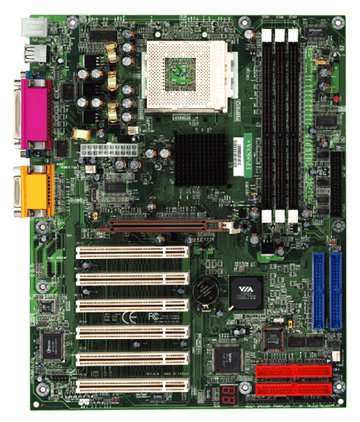
The picture is from the EPoX website and you can see the 8K3A+ is the board featured. As we mentioned earlier, the 8K3A is the same but minus the extra red RAID ports and the little P80P POST diagnostic module. Otherwise layout is identical.
As always, lets start at the top left and work our way across and down.
Starting in the top left area we have the main ATX power connector and the 3-phase power regulation circuitry and components that feed the CPU socket with power and in turn the rest of the board. The 3-phase power solution is said by EPoX to improve stability, especially in high speed situations when overclocked. They know enthusiasts run their boards out of spec and they know they are famous for boards that do so. So they developed the 3-phase solution for some of their boards to assist the enthusiast when overclocking and also to provide overall stability at stock speeds.
Moving to the right past that circuit and componentry we see the socket itself. It's rotated, presumably in conjunction with the 3-phase power to shorten the trace length to the power pins on the socket. I'm not a fan of rotated sockets since I used to run water cooling and rotating the socket when moving motherboard meant rotating and repositioning the water block. However with regular air coolers the socket rotation shouldn't be an issue.
The 3 DDR DIMM slots are located past the CPU socket on the right and support up to DDR333 memory and beyond. The floppy and IDE connectors are placed, ideally for this reviewer at least, on the right hand vertical edge of the board and aligned vertically. Thumbs up to EPoX for that connector placement.
The Northbridge is only passively cooled with no noisy fan which is a bonus. The KT333 Northbridge seems to run exceptionally cool. Running all the way up to 200MHz was possible on this board with no other cooling of the bridge required. The heatsink does the job fine and remained cool to the touch at all times, even under load.
Moving down past the passively cooled chip and we encounter very familiar territory. Everything from the AGP slot downwards is where it should be. 6 PCI gives you excellent expansion potential and everything from ATX case header to USB port header is placed in easy to find locations which the manual points out to you without issue.
The ATX case header is also properly labelled, something you don't see on all boards and I was able to connect my case headers without having to refer to the manual which is a nice rarity. Other manufacturers could take something from EPoX on that point since losing your motherboard manual isn't hard to imagine.
Installation was simple. The board uses a full 9-hole ATX mount and was an easy drop in replacement for the last board in the test chassis. No issues with installation at all, as it should be.
Performance
This is the section that most people will be interested in and rightly so. There would be no point in VIA releasing a chipset that's intended to replace the KT266A if it didn't offer increased performance in some areas leaving people with no incentive to buy a KT333 board.
Most focus on the chipset will be in the asynchronous memory mode where you run the board in 166:133 mode with your memory at DDR333 (166MHz) speeds and your CPU host bus at 133MHz.
So we'll take a look at performance from a number of angles. Firstly we'll look at overall system performance in both memory modes and then finally a quick look at some overclocking.
A quick note about this board and an explanation as to why we haven't reviewed it as soon as most. We've had the board for a little while but we've never been able to make the board work in asynchronous mode and detect any performance increase. While the BIOS would tell us we were running asynchrously, none of our benchmarks would show us that was the case.
I was a bit hasty in releasing a review of the board where I could see no discernable difference in the two modes since other reviews had shown a difference and a chat with EPoX UK assured me the board did run asynchronous. Shortly after my chat with EPoX, a new BIOS for the board reared its head and testing with that BIOS finally showed a difference in the two modes. So all the numbers you'll see in this review were garnered using the 8k3a2328.bin BIOS you can obtain here.
Finally, a 1/5 divider on an AMD based VIA chipset board
Finally before moving on the results we have to mention that the EPoX implements a 1/5 divider on the PCI bus when running over 166MHz, something that's been absent from many AMD boards and something that will appease the overclockers looking for a board that has no problems running at 166MHz and keeps PCI and AGP devices in spec.
Memory runs synchrously on the EPoX at anything over 166MHz so make sure your memory is up to it. Unlocked CPU's will also suit the board better since a full 33MHz increase in host clock doesn't suit many of the newer AMD Athlon XP's with their higher multipliers.
Performance results
So we'll be seeing results from 2 points with our graphs:
• 133Mhz host clock, 133MHz memory clock, 1333MHz CPU clock
• 133Mhz host clock, 166MHz memory clock, 1333MHz CPU clock
So before we move on to the results themselves, here's the test setup.
• EPoX 8K3A, KT333 Chipset, Socket A AMD DDR Motherboard
• Unlocked AMD Athlon XP1500+ Processor (1.33GHz, 10 x 133)
• 2 x 256Mb Samsung PC2700 DDR Memory Modules (CAS2)
• Gainward Ti550 GeForce3 Ti500 64MB
• Adaptec 39160 PCI SCSI Dual Channel U160 controller
• 2 x 73Gb Seagate Cheetah U160 10,000rpm SCSI disks
• Plextor 12/10/32S SCSI CDRW
• Pioneer 6x Slot-load SCSI DVD
• Creative Soundblaster Audigy Player Retail
• Windows XP Professional Build 2600.xpclient.010817-1148
• DetonatorXP 27.42 NVIDIA drivers
• POVRay v3.1g.msvc.unofficial-win32 dated 28 August 2001
• Aquamark v2.3
• Quake3 v1.30
• 3DMark 2001 Professional Second Edition
• Serious Sam: The Second Encounter Demo
Let's start off with the Sandra results for CPU Arithmetic. These are going to show the same numbers that any well sorted Socket A board will show for the same processor, in our case the XP1500 (1333MHz).
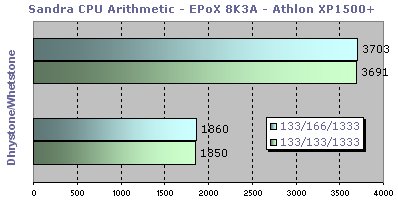
Nothing to look at there. The numbers are very similar to results we've gotten with this CPU on a wide number of boards. I'll skip the CPU Multimedia numbers except to say that there is a very small but detectable rise in the results when you go up to asynchronous mode. Less than 1% variance but repeatable.
Onto the memory benchmark figures from Sandra.

It's this graph that most people are going to see and think, "what's the benefit of running DDR333 then?" The answer lies in the front side bus/host clock of the system. What Sandra is really measuring here is the bandwidth the host processor can make use of from what's available from the memory controller. Think about it like that and you see why the figures are so close together.
The Athlon XP running on a 133MHz host clock can only make use of roughly 2.1GB/sec therefore 2.1GB/sec is the maximum you'll ever see from Sandra with an Athlon XP at 133MHz. We'll need to make use of other benchmarks to highlight the performance advantage that occurs. First of all however here's a nice POVRay graph that shows the CPU working properly and also the effect that increased memory bandwidth has on POVRay runs.
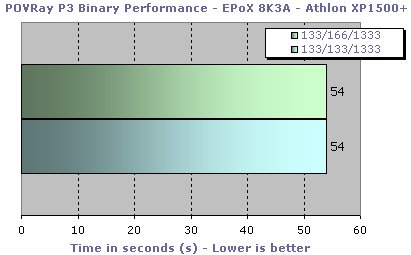
As you can see, POVRay is entirely CPU limited and has no interest in using our extra memory bandwidth. The graph just shows the CPU is working properly. 54s is what we expect from the bench scene run on the XP1500.
Next up we have Quake3. Given a fast graphics card, you are able to see the effect that memory bandwidth has on the system when you use Quake3. The fast graphics card allows you to remove it as a bottleneck in the system and leave other variables that influence system performance. In the following graph, all that is changed is the memory clock via a reboot.
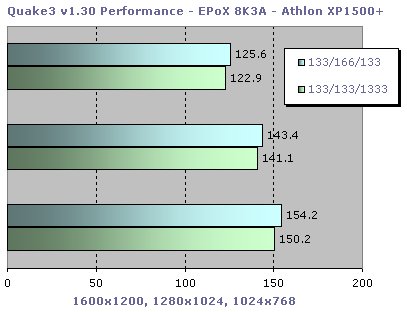
As you can see, running the memory bus at 166MHz and giving us the extra bandwidth shows us a slight but measureable performance increase. The effect isn't pronounced you need a combination of extra bandwidth and an overclocked host bus to take proper advantage of it but the increase does have an effect.
The results are also higher than a KT266A solution such as the EPoX 8KHA+ or Abit KR7A given identical components indicating the extra tweaking by VIA of the northbridge and memory controller between KT266A and KT333. At identical clocks, KT333 and hence the test board will be faster than KT333. Not by much, but measurable.
3DMark 2001 SE next. 3DMark will exhibit the same behaviour as Quake3 if the system is running correctly. A small but measurable increase in performance from the free memory bandwidth that we gain.
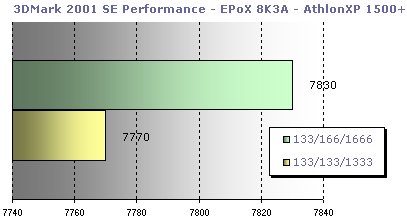
A 60 point gain (I measured over 100 points from some runs) doesn't seem like very much but it happens every time showing you that the memory bandwidth we have extra from KT333 is helping performance. Latency on DDR memory subsystems actually increases when you run asynchronous to the front side bus, negating some of the performance, but on the whole performance rises. We see that here and it's as we expected.
Onto Aquamark, our shader-heavy DirectX 8.0 benchmark that makes good use of a hardware DX8 accelerator such as the GeForce3 Ti500 in the test bed. Like before, a small but appreciable difference in performance is what we are looking for.

We get our performance difference as expected and we also gain higher 133/133 scores than any of our test KT266A solutions out of the box. Increased performance at stock clocks compared to KT266A (and indeed other AMD DDR chipsets) and a measureable increase in performance is what we expected and the EPoX 8K3A delivers.
Lastly in our look at general performance we have Serious Sam: The Second Encounter. We're looking for the same results here. More performance at stock clocks and our little increase when running asynchronous.
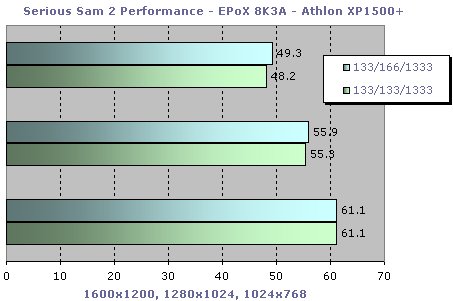
Again, predictably, we get what we expected. The results are higher than any KT266A results we've seen, although only by very small amounts which again highlights something we'll touch on in the conclusion so keep reading. Also, our asynchrous runs show the little increase we need to validate the mode.
Onto the performance conclusion where we'll also touch on some issues pertaining to the Athlon XP platform in general.
Performance Conclusion
So what can we say about KT333 performance and Athlon XP performance in general? It's quite obvious that KT333 is slightly better than KT266A in 133/133 synchronous mode and this is to be expected. VIA have tweaked the memory controller a little bit more since KT266A (the KT333 controller will appear in P4X333 soon) so performance at the same clocks will increase by a small margin.
In 133/166 asychronous mode, we see our slightly higher performance that we expect but it's nothing earth shattering and you have to wonder, worth the upgrade. The reason lies in the fact that the Athlon XP can't make much direct use of the extra bandwidth. Sure it leaves some free for the rest of the system to utilise, but by and large the headroom doesn't make much difference. Latency on the memory increases actually negating some of the new bandwidth performance you get. DDR memory is happiest running at the same clock as the host bus (front side bus) so that wait states between the two are minimised.
That leads us nicely onto a general observation about the platform. It's quite obvious that Athlon XP could do with a front side bus hike to let it use more memory bandwidth. A move to 166MHz memory clock coupled with new DDR400 memory would give the platform an overall performance boost. The CPU can use 2.7GB/sec and the system has some extra for itself. The higher speed offsets some of the latency increase and everything moves a bit faster. Multipliers can be lowered and given a proper process shrink, the CPU has some headroom left in it for a while before Hammer hits.
AMD seems to have shot itself in the foot however by not increasing front side bus clock or doing some of the other things to help out a lack of bandwidth like a large on die L2 cache. Thoroughbred will stick at 133MHz front side bus and we won't see 512kb of L2 on the CPU either. Speed will increase by multiplier only.
KT333 and in future, KT400 will give the system some more memory bandwidth as processor speed marches on but is it enough? Our results on the EPoX 8K3A while excellent, aren't really enough for the future. We'll have to wait and see with the processors themselves but reliance on a 133MHz front side bus isn't helping the platform as a jump to 166MHz would.
As far as the board itself goes, it's the quickest Socket A AMD DDR board I've had the pleasure to test. While I can't directly compare it to Spy's recent MSI KT3 Ultra ARU review since we used different processors and benchmarks, the performance of them both is strikingly similar, something we expected. For ages now, boards from different manufacturers but with the same chipset are often withing a percentage point of each other.
Excellent performance all round from the board, no question.
Overclocking
I wont dwell on overclocking for long except to prove the effect of overclocking the front side bus and letting the CPU have greater bandwidth. Here's a cropped screen grab from Sandra showing the effect that a 166MHz memory and host clock has.
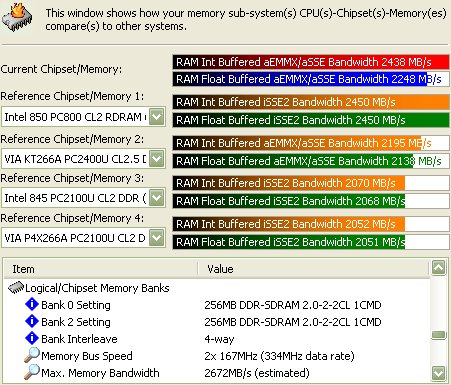
The addressable bandwidth increases as CPU host clock increases and the memory clock matches or exceeds it.
As far as overclocking the board went, large front side bus was easy. Dropping down to 9.5x multiplier which doesn't always work on my now semi unlocked processor allowed me to run around 180MHz front side bus with ease and the board will go higher if you give it the right components.
People are already taking this board to 200MHz front side bus without doing anything special. The board overclocks like a champion, that's all there is to it. You have a massive range of voltage options available to you without modification (2.2V on the CPU and 3.2V on the DDR memory) and the voltage seems to be stable at high front side bus speeds unlike on the old 8K7A (hybrid AMD/VIA chipset) which drew massively on the 5V rail.
The board enjoys the 3-phase power circuitry to provide stable overclocks. Before I close things off with a conclusion proper, here's a cropped WCPUID screen grab. Stock CPU voltage (1.75V) on the little XP1500 and a simple increase to 166MHz front side bus. All completely stable (I write this at that speed, on this board, as you read!).
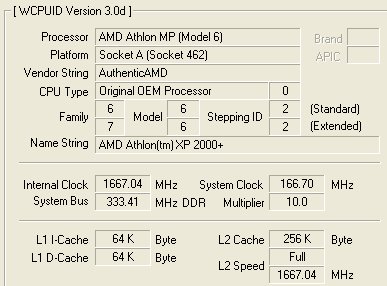
Conclusion
So what is the EPoX 8K3A like in practise after all the benchmarks are run and all the talk about KT333 is over? It's one of the most stable boards I've yet seen, something I maybe couldn't say about EPoX in the past. Not a blue screen throughout testing, no instability unless at the very ragged edge and pushing it to the extreme. A notch below the physical limits of the rest of the system and things were outstandingly stable, something EPoX have worked hard on.
The feature set, while lacking some peripheral finery like we saw on the KT3 Ultra ARU, is adequate for the target audience who want 6 PCI and overclocking features more than USB2.0 and RAID.
Layout is sensible despite with a couple of niggles that are mostly personal (rotated socket and slightly goofy ATX power socket placement).
Performance as we've seen is excellent with only the worries about overall system bandwidth which aren't EPoX's fault. They don't make chipsets and can only work with what they are given.
1/5 PCI and AGP divider at 166MHz+ front side bus is a massive boon and lets you run things in spec, something I'm doing as we speak and I'm sure my SCSI card is thanking me!
The bundle is unexciting but that lets EPoX keep the cost down, something we all appreciate. Overall very fast, very stable and just what the overclocking doctor ordered. Not as feature heavy as others but I think that's a good thing for the target audience. KT333 isn't a massive step from KT266A so upgrading takes more thought but the EPoX implements it well. Be sure to run a recent BIOS!
A pleasure to test, the 8K3A is fast and stable. Just how motherboards should be.
Pro's
• Speed, and lots of it
• 1/5 PCI and AGP divider at 166MHz+ front side bus
• Good expansion from 6 PCI slots
• Cheap
• Stable
• Overclocks well and painlessly too with lots of voltage options
Cons
Comparative lack of features
Needs a recent BIOS for certain things to work properly
Where's the POST code reporter?
|